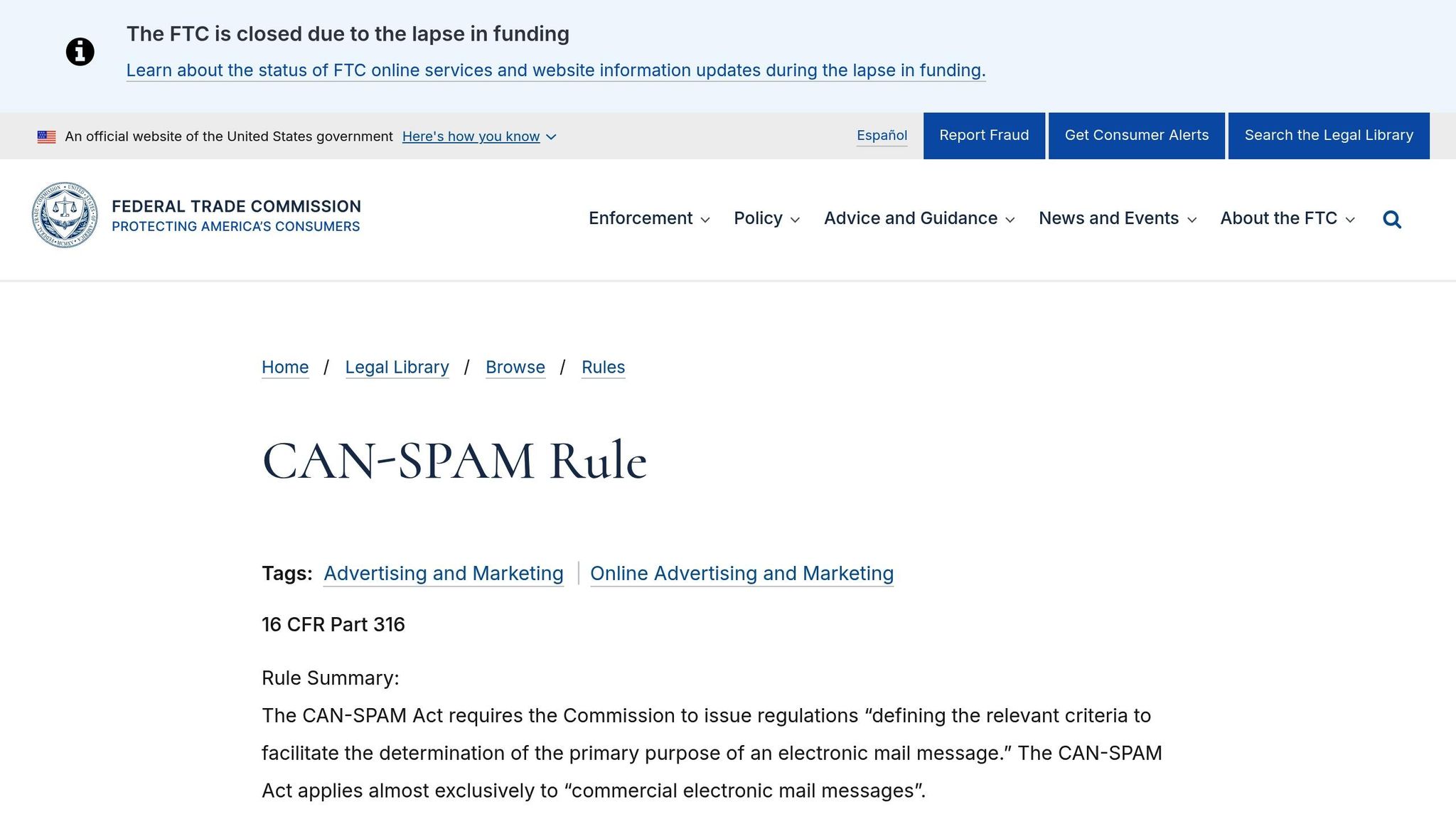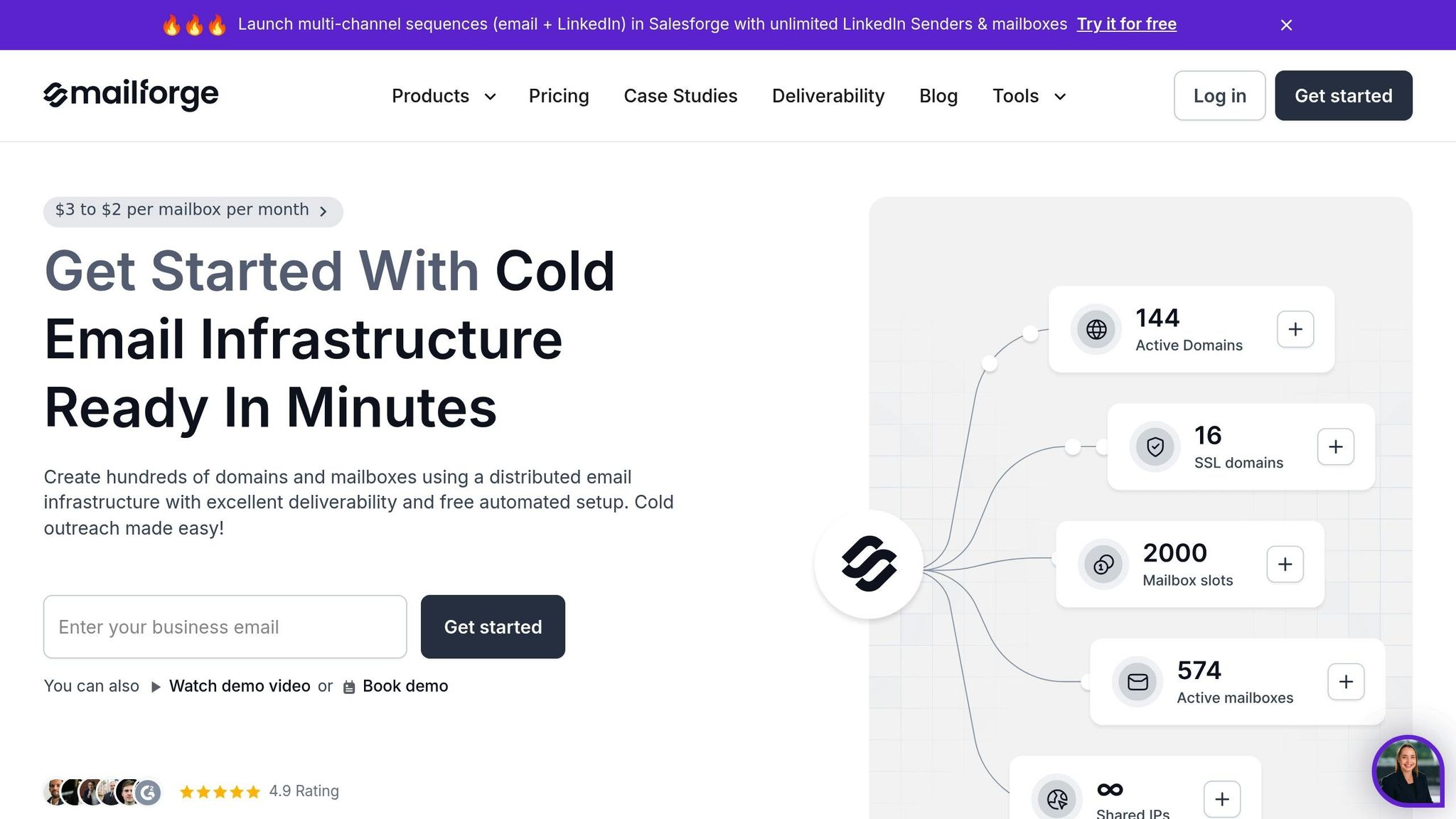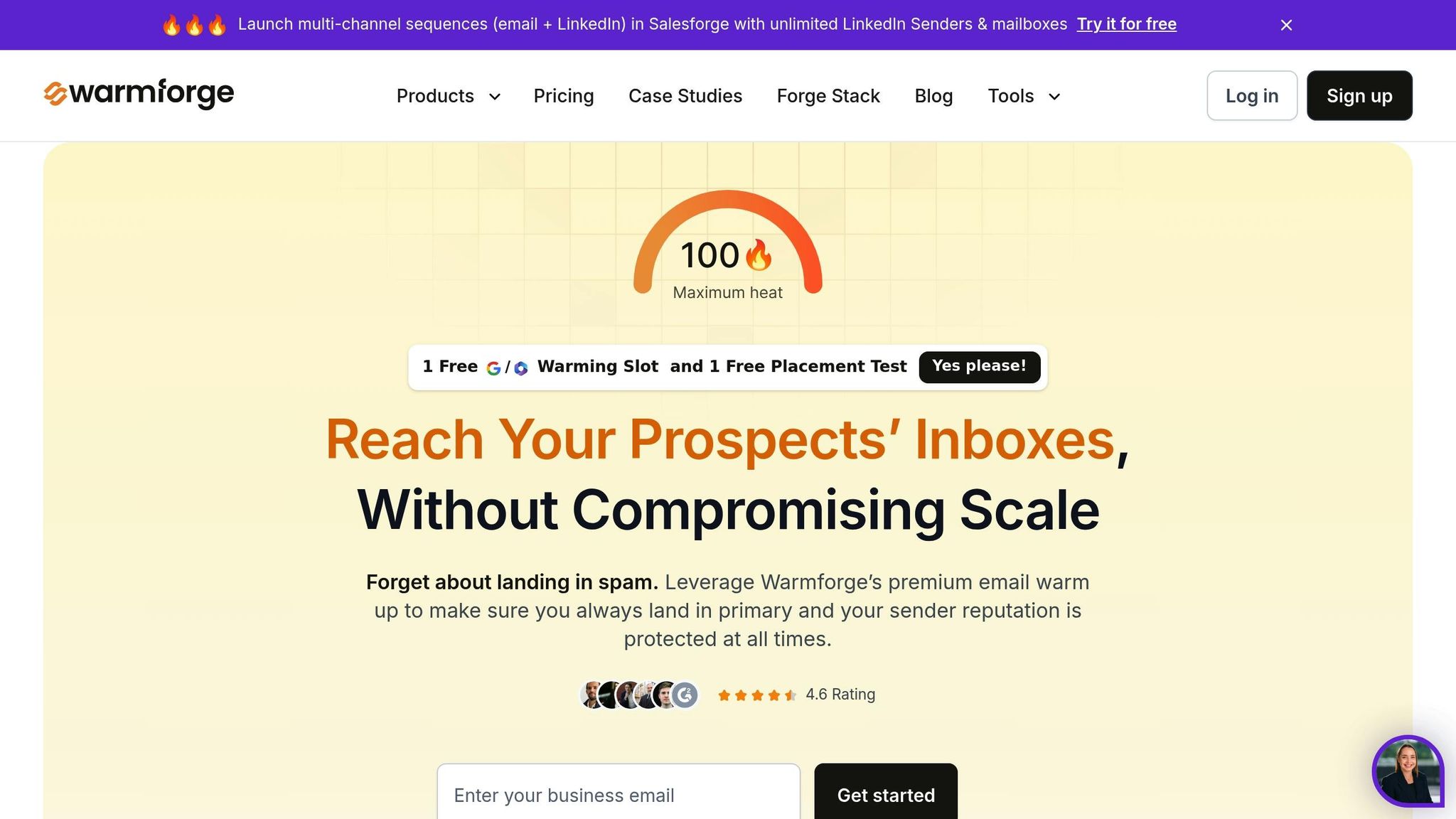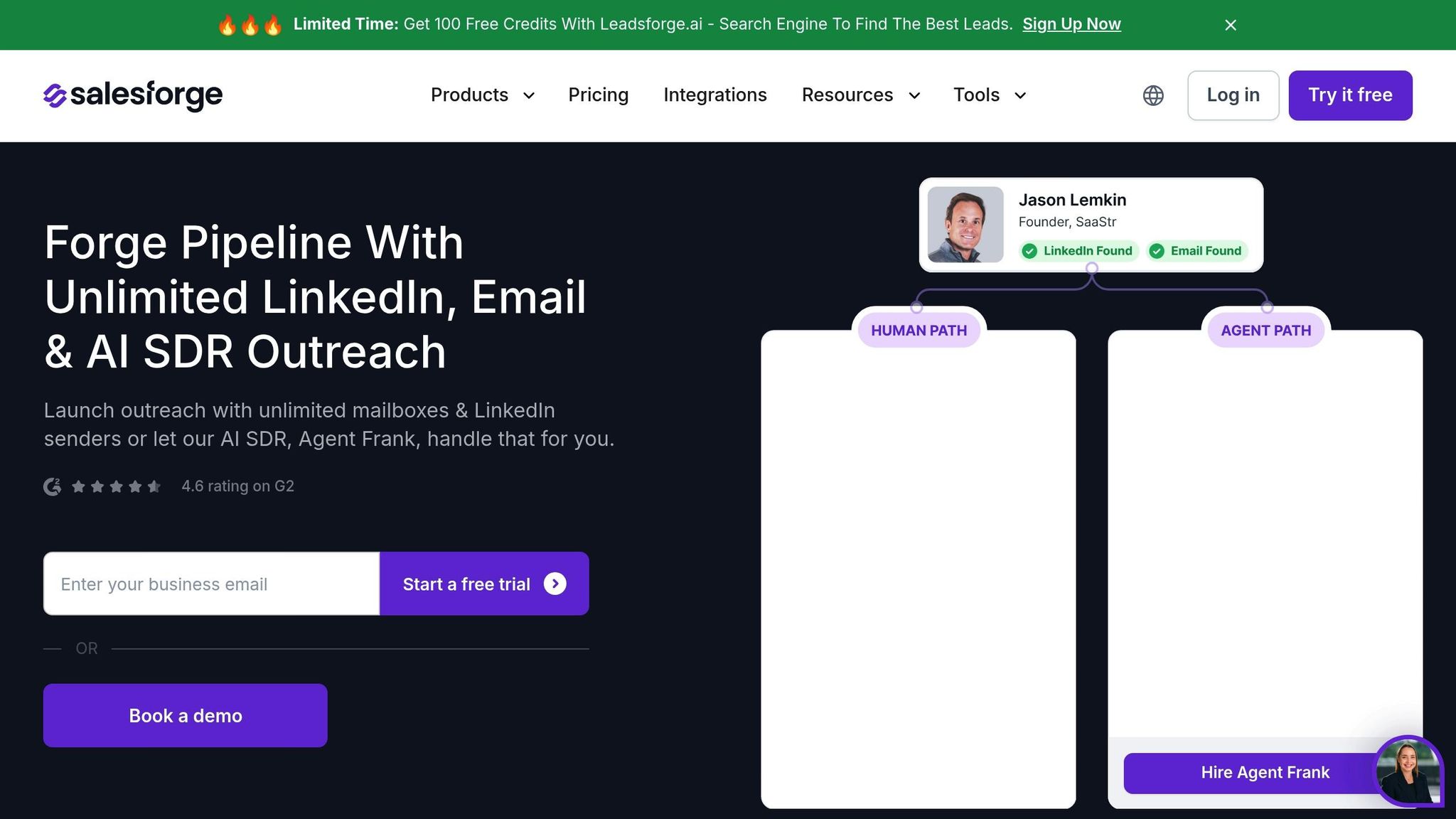How Do You Stop Emails Going to Spam?
Landing emails in inboxes instead of spam requires a mix of technical setup and thoughtful practices. Here's the quick answer:
-
Set Up Proper Infrastructure:
- Use a dedicated domain or subdomain for outreach.
- Configure DNS records (SPF, DKIM, DMARC) to authenticate emails.
- Decide between shared or private infrastructure based on email volume and control needs.
-
Protect Your Sender Reputation:
- Gradually warm up your domain and IP with small email volumes.
- Monitor bounce rates, spam complaints, and engagement metrics.
- Regularly clean your email lists to avoid inactive or invalid addresses.
-
Write Emails That Pass Spam Filters:
- Avoid spammy words and misleading subject lines.
- Include a clear unsubscribe link and a valid physical address.
- Follow laws like the CAN-SPAM Act for compliance.
-
Use Tools to Simplify the Process:
- Platforms like Mailforge automate domain setup, warm-up campaigns, and authentication checks.
- Tools like Salesforge and Leadsforge streamline lead generation and email sequences.
Building Strong Email Infrastructure
Think of your email infrastructure as the backbone of your email campaigns. It’s not just about having an email account - it’s about creating a system that email providers trust to deliver your messages. This means setting up your domain, configuring DNS records, securing SSL certificates, and properly organizing your mailboxes to establish credibility.
The good news? Modern tools make this process much easier. Instead of wrestling with manual DNS configurations or troubleshooting authentication issues, you can rely on platforms that automate these tasks while ensuring your setup meets today’s deliverability standards.
Domain and Mailbox Setup
Your domain is the foundation of your email outreach. To protect your primary business domain from potential deliverability issues, use a subdomain for cold outreach, such as outreach.company.com. This keeps your main email communications safe while allowing you to run outreach campaigns effectively.
When creating mailboxes, avoid generic email addresses like info@ or sales@. These can trigger spam filters. Instead, use personalized addresses tied to your team members, such as john.smith@outreach.company.com or sarah.jones@sales.company.com. These look more authentic and help build trust with recipients.
Proper DNS configuration is crucial. Records like MX, SPF, DKIM, and DMARC ensure your emails are authenticated and routed correctly. For example, MX records guide other servers on where to deliver mail for your domain.
Platforms like Mailforge streamline this process by automating domain configuration, SSL certificate setup, and domain masking. When you connect a domain, the system handles all the technical details, saving you time and ensuring your infrastructure is optimized for email deliverability.
SSL certificates are another essential piece of the puzzle. They encrypt your email connections, which boosts sender trust. Most modern platforms take care of SSL installation and renewal automatically, so you don’t have to worry about it.
Shared vs. Private Infrastructure
Once your domain and mailboxes are ready, it’s time to decide between shared and private infrastructure. Your choice depends on your email volume and the level of control you need.
Shared infrastructure is a cost-effective option, especially for businesses new to cold email outreach. It pools resources across multiple users, giving you access to warmed IP addresses and a proven sending setup without the hassle of managing your own servers. Platforms like Mailforge operate on this model, offering fast setup and reliable deliverability. You can start sending emails immediately without waiting to warm up new IP addresses, which is a huge advantage for beginners.
However, shared infrastructure does have its downsides. Since you’re sharing resources with other users, their poor practices - like sending spam - could impact your deliverability. You’ll also have less control over sending schedules and may face volume limits during peak times.
Private infrastructure, on the other hand, gives you full control. With dedicated IP addresses and servers, your sending reputation is entirely your own. This setup is ideal for businesses with high email volumes or specific compliance needs. For example, Infraforge offers private infrastructure solutions with advanced features like multi-IP provisioning and API access. This allows you to distribute your email load across multiple IPs, reducing the risk of any single IP being flagged while maintaining high sending volumes.
For businesses targeting U.S. markets, Primeforge provides Google Workspace and Microsoft 365 mailboxes with U.S.-based IP addresses. This can improve deliverability when emailing American prospects, as some email providers consider the sender’s location in their filtering algorithms.
So, how do you choose? If you’re sending fewer than 10,000 emails per month and want a low-maintenance option, shared infrastructure through Mailforge is a great choice. But if you’re dealing with higher volumes or need more control, private solutions like Infraforge or Primeforge offer the scalability and customization you need.
Ultimately, a strong email infrastructure ensures your messages consistently land in inboxes, setting the stage for successful cold outreach campaigns.
Setting Up Email Authentication Protocols
If you want your emails to avoid the dreaded spam folder, setting up proper authentication is non-negotiable. Email authentication protocols, like SPF, DKIM, and DMARC, help prove to email providers that you're the real deal. Without these in place, your emails might look suspicious and end up flagged as spam. These protocols work together to verify your identity and protect your domain from spoofing attacks.
Think of it as a three-layer security system. Each protocol strengthens your email's chances of landing in the inbox. Providers like Gmail, Outlook, and Yahoo rely on these signals to decide where your emails should go.
Configuring SPF, DKIM, and DMARC
SPF (Sender Policy Framework) is like a guest list for your domain. It tells receiving servers which IP addresses are allowed to send emails on your behalf. To set it up, you'll need to add a text record to your domain's DNS settings. Here's an example of a basic SPF record:
v=spf1 include:_spf.google.com ~all
This record authorizes Google's servers to send emails for your domain.
If you're using multiple email services for outreach, your SPF record might look something like this:
v=spf1 include:mailforge.com include:_spf.google.com ~all
This setup allows both Mailforge and Google servers to send emails for your domain.
DKIM (DomainKeys Identified Mail) takes things a step further by adding a unique digital signature to your emails. This signature is created using a private key that only you control. On the receiving end, servers verify the signature using a public key stored in your DNS records. A typical DKIM record might look like this:
selector._domainkey.yourdomain.com
The value of this record will contain your public key details.
Mailforge simplifies DKIM setup by generating the necessary keys and providing the exact DNS records you need to add.
Once SPF and DKIM are good to go, you can implement DMARC (Domain-based Message Authentication, Reporting, and Conformance). DMARC ties everything together by specifying what actions should be taken if an email fails authentication checks. To set it up, add a text record named _dmarc.yourdomain.com with content like this:
v=DMARC1; p=quarantine; rua=mailto:dmarc@yourdomain.com; ruf=mailto:dmarc@yourdomain.com; fo=1
DMARC policies include three options:
- none: Monitor email activity without enforcement.
- quarantine: Mark failed emails as spam.
- reject: Block failed emails entirely.
Start with the "none" policy to monitor how your emails perform, then gradually tighten the policy to "quarantine" or "reject." Make sure SPF and DKIM are fully set up first, and wait about 48 hours for DNS changes to propagate before enabling DMARC.
Using Tools for Authentication Checks
Even after setting up SPF, DKIM, and DMARC, regular checks are crucial. DNS changes can take up to 48 hours to propagate worldwide, and updates to your website or hosting can sometimes mess with your records.
Mailforge offers built-in tools to monitor your authentication setup. It continuously checks your records and sends alerts if anything is missing or misconfigured.
DMARC reports are another valuable resource. These weekly reports from major email providers show which emails passed or failed authentication checks and can even highlight spoofing attempts. Mailforge takes these XML reports and transforms them into easy-to-read dashboards, so you can quickly spot any issues.
Make it a habit to review your records monthly, especially after DNS updates, hosting changes, or when adding new email tools. Set up monitoring alerts to stay on top of any authentication failures.
If you use multiple email tools, like Salesforge or Warmforge, managing authentication can get tricky. Mailforge simplifies this by centralizing authentication management, ensuring all your tools are properly configured.
Protecting Your Sender Reputation
Once you've set up a solid email infrastructure and authentication, the next big step is safeguarding your sender reputation. Why does this matter? Because Internet Service Providers (ISPs) closely monitor your sender reputation to decide whether your emails land in inboxes or get flagged as spam. They evaluate factors like bounce rates, spam complaints, and audience engagement. And here's the kicker - if your reputation takes a hit, it's incredibly tough to recover.
ISPs assess your domain and IP address reputation, along with your overall email-sending habits. For instance, sending a large volume of emails too quickly - especially from a new domain - can raise red flags. This kind of activity often leads to your emails being filtered out as spam, even if you have the best intentions.
The tricky part? Building a strong sender reputation takes time, but most businesses need to start sending emails right away. It’s a delicate balancing act: achieving good deliverability depends on your reputation, but your reputation also grows with consistent deliverability.
Running Email Warm-Up Campaigns
Email warm-up is like easing into a workout routine - you start slow and build up gradually. The idea is to establish trust with ISPs by slowly increasing your email-sending volume over time. Jumping straight into high-volume email campaigns, especially from a fresh domain, is a surefire way to trip spam filters.
Platforms like Warmforge make this process easier by automating the warm-up phase. They send emails between real accounts to mimic natural engagement that ISPs recognize. The process starts with a small number of emails each day, gradually increasing over several weeks. A well-designed warm-up schedule is tailored to factors like your domain's age, infrastructure, and target audience.
Warmforge also conducts inbox placement testing during the warm-up phase. This involves sending test emails to major providers to see where they land - in the inbox, promotions tab, or spam folder. These insights help you fine-tune your strategy before launching large-scale campaigns.
Tracking Key Performance Metrics
To maintain a strong sender reputation, you need to keep a close eye on key metrics. Start by monitoring bounce rates, spam complaints, and engagement levels. Regular list cleaning is a must - removing invalid or unresponsive email addresses helps keep your metrics healthy. Many ISPs provide feedback loops, which notify you when recipients flag your emails as spam. Use this information to immediately remove those contacts from your mailing list.
Engagement metrics like open rates, click rates, and even the time people spend reading your emails are also critical. Low engagement suggests your content isn’t connecting with your audience, which can hurt your reputation and push future emails into spam folders.
Maintaining good list hygiene is just as important. This means routinely scrubbing your email lists to eliminate bounced addresses, inactive subscribers, and potential spam traps. Tools like Salesforge simplify this process with built-in list-cleaning features that automatically suppress problematic addresses.
Consistency is another major factor. ISPs prefer predictable email-sending patterns over sporadic bursts. By sticking to a steady schedule, you reinforce your domain’s legitimacy and avoid triggering spam filters.
For real-time insights, Mailforge offers a dashboard that tracks metrics like bounce rates, engagement levels, and authentication issues. If something goes wrong - like a sudden drop in engagement or a spike in bounce rates - the platform alerts you, giving you a chance to fix the issue before it spirals.
Finally, if you're using dedicated IPs through services like Infraforge, pay extra attention to your IP reputation. Dedicated IPs give you full control over your sending reputation, unlike shared IPs, where the reputation is influenced by multiple senders. While this added control is a bonus, it also means the responsibility for maintaining a good reputation falls entirely on you.
Writing Emails That Avoid Spam Filters
When sending commercial emails, it's crucial to follow the rules outlined in the CAN-SPAM Act. Doing so not only ensures you stay compliant with the law but also helps establish trust with recipients and boosts your email deliverability.
Following CAN-SPAM Act Requirements

The CAN-SPAM Act applies to all commercial emails, whether you're sending bulk marketing campaigns or one-off business-to-business cold emails. Sticking to these rules can help you avoid spam filters and maintain a good reputation.
- Use accurate header information. Make sure the "From", "To", and "Reply-To" fields clearly and truthfully identify the sender. Misleading or fake details can trigger spam filters and hurt your credibility.
- Write honest subject lines. Your subject line should reflect the actual content of your email. Avoid clickbait or misleading phrases that don't align with your message. For example, don’t promise "free gifts" if there’s a catch.
- Clearly identify promotional content. If your email is promoting a product, service, or offer, make it obvious. Transparency is key to avoiding complaints and maintaining trust.
- Include a valid physical address. Every email must include a legitimate mailing address - this could be your office address, a registered P.O. Box, or another valid option. This detail reassures recipients that you're a legitimate sender.
- Provide an easy unsubscribe option. Make it simple for recipients to opt out of future emails. A clear and accessible unsubscribe link not only keeps you compliant but also improves your chances of staying out of spam folders.
One important note: Unlike laws like GDPR in Europe, the CAN-SPAM Act does not require you to get explicit consent before sending commercial emails in the U.S. However, being respectful and thoughtful in your approach can still go a long way.
Using Mailforge's Tools for Better Deliverability

Getting emails into inboxes requires more than just good content - it demands the right tools. Mailforge offers a comprehensive platform designed to address every aspect of email deliverability, from setting up your infrastructure to managing automated outreach. These tools work together to ensure your emails consistently land where they’re supposed to: the inbox.
Testing Email Placement with Warmforge

Before you hit "send" on a cold email campaign, it’s critical to know where your emails are ending up. That’s where Warmforge steps in. This tool runs placement tests to show how major email providers like Gmail, Outlook, and Yahoo handle your messages.
With these tests, you’ll get a clear view of your placement rates for each provider. If you notice one provider consistently flags your emails as spam, you can address the issue before it affects your campaign. Warmforge also automates domain warm-up by gradually increasing your sending volume and mimicking natural engagement patterns - taking the guesswork out of email infrastructure preparation. These insights feed directly into your outreach and lead generation strategies, giving you a head start.
Connecting Salesforge and Leadsforge

Leadsforge simplifies lead generation by helping you create targeted, verified lead lists in just minutes. Describe your ideal customer profile, and the platform will find matching contacts with validated email addresses.
Once your leads are ready, Salesforge takes over. This tool manages your entire cold email sequence, from the first message to follow-ups, with campaigns that adapt automatically based on how recipients respond. You can create multi-step email strategies that adjust in real time, ensuring your outreach is always relevant.
The best part? These tools are seamlessly connected. When Leadsforge identifies a prospect that fits your criteria, Salesforge can instantly add them to the right campaign. This smooth integration keeps your outreach running efficiently, with no interruptions or manual updates required.
Agent Frank: AI-Powered Outreach

Mailforge’s automation reaches a new level with Agent Frank, an AI-powered assistant that handles everything from sourcing leads to managing campaigns. Agent Frank combines the capabilities of Leadsforge, Salesforge, and Warmforge into one streamlined system.
This AI doesn’t just send emails - it manages follow-ups, replies, and even schedules meetings directly on your calendar when prospects show interest. Plus, it uses performance data to refine your strategies. For example, if a particular subject line works better with a specific audience, Agent Frank will adjust your messaging to match. This kind of real-time optimization lets you scale your efforts without adding extra work for your team.
When combined with the authentication and reputation strategies you’ve already put in place, these tools create a complete deliverability system. Together, they ensure your emails not only get delivered but also make an impact.
Steps to Get Your Emails in the Inbox
When it comes to ensuring your emails land in inboxes rather than spam folders, success hinges on four key pillars. These pillars work together as a system, creating a foundation for consistent and reliable email delivery.
1. Build a Solid Infrastructure
Start by setting up a strong infrastructure. Use dedicated domains and decide whether shared or private infrastructure suits your needs. Tools like Mailforge can simplify this process by automating DNS setup, making it quick and easy to create domains and mailboxes.
2. Authenticate Your Emails
Authentication is critical. Protocols like SPF, DKIM, and DMARC confirm your legitimacy as a sender. Without proper authentication, even well-crafted emails may end up in spam folders. Make sure these protocols are implemented accurately to boost your credibility.
3. Protect Your Sender Reputation
Your sender reputation plays a major role in deliverability. High engagement rates and minimal spam complaints are essential. Gradually warm up your domain using tools like Warmforge to establish trust with email providers over time.
4. Craft Compliant and Engaging Content
The content of your emails matters just as much as the technical setup. Avoid using spam-trigger words, always include a clear unsubscribe link, and comply with the CAN-SPAM Act. Your subject lines should be straightforward and honest, while the email body should offer real value to your recipients. Keep in mind that higher engagement directly improves your chances of landing in inboxes.
Leverage the Right Tools
To streamline the process, consider using tools specifically designed for email success:
- Leadsforge: Helps you build verified lead lists.
- Salesforge: Manages your email sequences efficiently.
- Agent Frank: Automates everything from lead generation to scheduling meetings.
FAQs
What are the advantages of using a private email infrastructure instead of a shared one for better email deliverability?
Using a private email setup gives you complete control over your sender reputation. Since you're not sharing IP addresses with other users, you won't have to worry about someone else’s bad practices affecting your email deliverability. This helps ensure your emails consistently land in inboxes where they belong.
It also boosts security and compliance, making it a great choice for high-volume or sensitive email campaigns. With dedicated resources at your disposal, your emails are better equipped to pass through spam filters and maintain a trustworthy, professional presence in recipients’ inboxes.
How can I write engaging emails that comply with the CAN-SPAM Act?
To craft emails that resonate with recipients while staying compliant with the CAN-SPAM Act, focus on clarity and integrity. Start by ensuring your header information - such as the 'From' and 'Reply-To' fields - is accurate and represents who you are. Your subject lines should be straightforward and reflect the actual content of the email. If your message is promotional, make it clear when required.
Include your physical mailing address in the email, and offer a simple, easy-to-find option for recipients to opt out of future communications. Make sure to honor opt-out requests promptly - within 10 business days - to stay within the law. By adhering to these guidelines, you not only comply with regulations but also build trust with your audience, making your emails more impactful and trustworthy.
What are the best ways to monitor and improve my sender reputation to keep emails out of spam?
Maintaining a solid sender reputation is crucial if you want your emails to reliably land in your recipients' inboxes. There are tools out there specifically designed to help you keep tabs on your IP and domain health. These tools can flag potential problems, offer real-time updates on issues like spam complaints or blacklist status, and help you monitor authentication protocols - all of which play a big role in email deliverability.
To stay ahead of potential issues, it's worth exploring email infrastructure tools that come with features like private IP management, automated warm-up processes, and in-depth reputation analytics. Keeping a close eye on your sender reputation not only builds trust with email providers but also boosts your chances of consistently connecting with your audience.